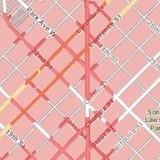
Roughly eight months after it first turned on its mobile 5G network, Verizon is now offering detailed, street-level maps illustrating its 5G coverage areas.
The action by Verizon helps to provide more specificity around the operator's 5G efforts, and also represents a counter to some of its competitors' criticisms. Specifically, T-Mobile used the lack of 5G coverage maps from Verizon as the centerpiece of its "verHIDEzon" advertising campaign.
Prior to the launch of its online 5G coverage maps, Verizon simply listed the neighborhoods where its 5G signal might be available.
Figure 1: Verizon's 5G Coverage in Downtown Denver  Source: Verizon
Source: Verizon
PCMag first noted the appearance of Verizon's 5G coverage maps. Importantly, the publication also reported that Verizon's 5G coverage areas appear to have grown noticeably in locations such as New York City since the operator first launched services.
Why this matters
Coverage maps are clearly an obvious and necessary element of any wireless offering. And T-Mobile and Sprint already offer detailed coverage maps for their own respective 5G networks. (AT&T, meantime, still has not begun selling 5G to regular customers.)
But the maps from Verizon not only provide some measurable and demonstrable clarity to the operator's nascent 5G efforts, they also underscore the scale of Verizon's 5G undertaking. Because Verizon is using millimeter-wave (mmWave) spectrum for its "ultra wideband" 5G rollout, it will need to install thousands, or perhaps even millions, of small cell transmitters every few hundred feet in order to blanket a major city like Los Angeles with 5G coverage. That's because transmissions in mmWave spectrum can't travel more than a few thousand feet in the best of conditions, and can't go through things like buildings or trees.
Thus, a widespread 5G mmWave network is a potentially expensive proposition.
Nonetheless, Verizon's executives have maintained that the operator will deploy mmWave 5G across parts of 30 cities this year (just today Verizon announced it switched on 5G services in Boston; Houston; and Sioux Falls, SD -- bringing the total number of its mobile 5G cities to 18). Moreover, they continue to argue that mmWave 5G is "real" 5G, and that 5G offerings in lower spectrum bands, like those that T-Mobile and AT&T are planning to use, won't be demonstrably different than 4G. These kinds of statements do help highlight Verizon's wealth of mmWave spectrum as compared with its rivals, and the blazing fast speeds of more than 1Gbit/s it can provide on its mmWave 5G network, but they also set a very high bar for Verizon to clear in its 5G buildout.
Verizon has not yet said how it might expand its 5G network next year -- and neither Verizon nor AT&T has expressed any desire to increase spending on their networks in the years to come.
Finally, it's also worth noting that both AT&T and Verizon said the FCC should not include 5G in its efforts to create accurate maps of Americans' broadband networks.
— Mike Dano, Editorial Director, 5G & Mobile Strategies, Light Reading | @mikeddano
About the Author(s)
You May Also Like










